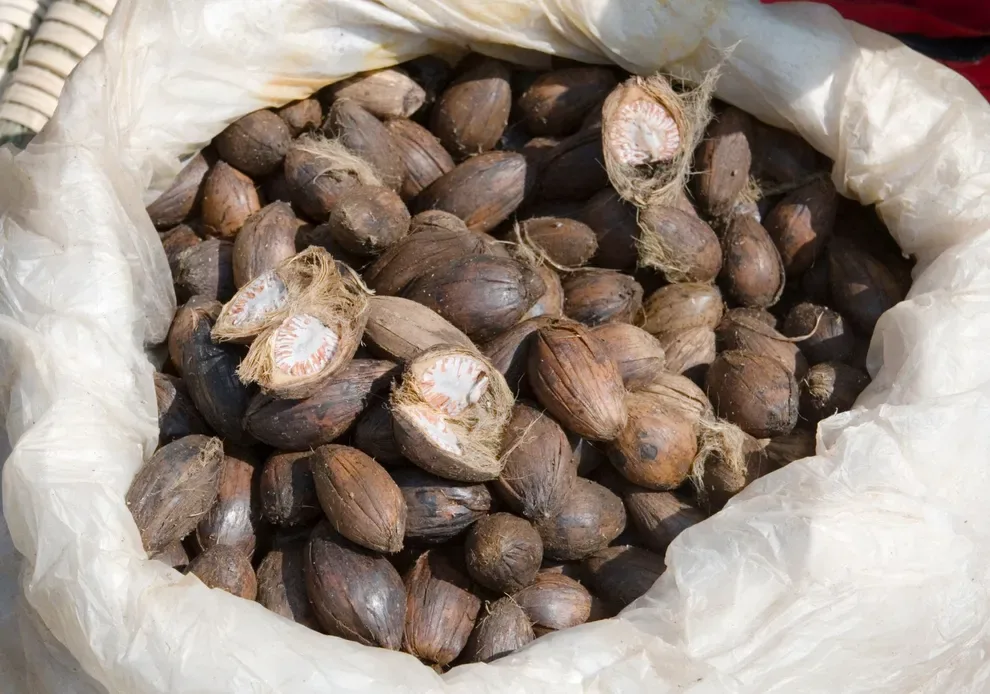Betel Nut & Teeth

Table of Contents
- Culturally Ingrained Habit
- Betel Nut’s Popularity
- Oral Health Damage from Betel Nuts
- Dental Treatment for Betel Nut Chewers
- Steps Countries & Cultures are Taking to Curb Usage
- References
Stained teeth and cavities are results of betel nut addiction. Long term, people who chew betel nut have a higher risk of oral cancer.
Betel nut chewing is a common practice in Southeast Asia. It offers the shock of a stimulant drug and potentially some pain relief, even from toothaches.
Betel Nut: A Culturally Ingrained Habit That Damages Teeth
The betel nut, also called the areca nut, is a seed from the fruit of the areca palm tree, which is common throughout Southeast Asia. Chewing the betel nut releases a stimulant drug that gives a rush of euphoria, or happiness, and stamina, which wears off fairly quickly.
It is increasingly common among people who live in Southeast Asia, or who have immigrated from that region to other countries, to chew betel nut along with a plug of tobacco. While tobacco is a regulated substance in the United States, the betel nut is not, so it is freely imported.
While chewing the areca nut is not as common in the US as smoking tobacco or drinking alcohol, it is a common practice among migrant populations, so it is possible that the dental problems associated with betel nut addiction will become more prevalent. Dental problems are worsened when betel nut is combined with tobacco, which increases the risk of lesions and oral cancers.
The leading reason for chewing betel nuts is the energy boost it produces and is likely from the nut’s natural alkaloids, which release adrenaline.
Betel Nut’s Popularity
The most common sign of betel nut addiction is a stain on the teeth, ranging from reddish-brown to purple to black. Most of the staining comes from the betel nut itself, but adding spices, tobacco, and sweeteners increases potential tooth staining.
About 600 million people worldwide chew betel quids, or nuts, making this the fourth most used psychoactive substance. Tobacco, caffeine, and alcohol are the only three more popular substances.
There may be some pain-relieving effects with betel nut, which is sometimes used in parts of Southeast Asia as an herbal remedy for toothaches. Occasional use may not lead to oral health problems. However, since betel nut is addictive, people who use it are more likely to do so consistently, greatly increasing their risk of stained teeth and oral cancers.
What Oral Health Damage From Betel Nut Looks Like
Harm associated with chewing betel nut, with or without tobacco, includes:
Stained teeth, which damages overall appearance.
Damaged teeth, with more cavities, cracks, or chips.
Teeth coming loose and falling out.
Precancerous lesions or wounds in the mouth, which may look like red or white patches in the throat, cheeks, gums, or tongue.
Oral cancer of the lip, tongue, pharynx, or mouth.
Oral cancer of the esophagus (throat).
Stomach cancer.
A medical study published in 2008 surveyed 1,000 participants (994 people responded to surveys), ranging in age from 30 to 50 years old. About 32 percent of respondents had a higher risk of oral health problems, especially cavities and bleeding from the gums due to damage or gingivitis.
While the study found that brushing teeth at least once per day improved oral health and reduced the risk of cavities in betel nut chewers, their perception of their oral health was no different regardless of oral hygiene routine. About 80 percent of the survey respondents did not regularly visit a dentist. Everyone who participated reported that they knew betel nut chewing could damage their oral health, along with smoking and eating sweets.
Dental Treatment Is Important for Betel Nut Chewers
Health campaigns across Southeast Asian countries have attempted to stop or reduce betel nut chewing for decades, similar to the public health advertisements against smoking in the US. It is difficult to know whether these campaigns have an effect, as betel nut chewing is ingrained in many cultures in that area and has been for thousands of years.
As more health studies about the betel nut are published, and more health officials speak out against chewing this drug, rates of betel nut chewing may begin to decline. Improving access to dental care can also help to reduce the risk of harm from betel nut chewing.
Steps Countries & Cultures are Taking to Curb Usage
The popularity and longevity of betel nut chewing in southeastern Asia complicates intervention methods. However, the sheer volume of health problems associated with this psychoactive substance has caused governments to step up and try to stop people from using it as frequently.
There are four main methods used to try and control betel nut usage:
